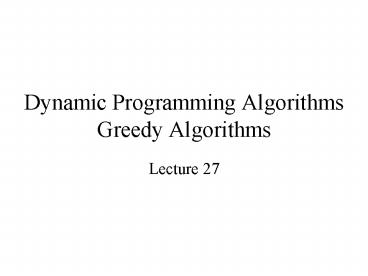Dynamic Programming Algorithms Greedy Algorithms PowerPoint PPT Presentation
1 / 12
Title: Dynamic Programming Algorithms Greedy Algorithms
1
Dynamic Programming AlgorithmsGreedy Algorithms
- Lecture 27
2
Return to Divide-and-Conquer
- Divide-and-Conquer
- Divide big problem into smaller subproblems
- Conquer each subproblem separately
- Merge the solutions of the subproblems into
the solution of the big problem - Example
- Fibonnaci(n)
- if (n ? 1) then return n
- else return Fibonnaci(n-1) Fibonnaci(n-2)
- Very slow algorithm because we recompute
Fibonnaci(i) many many times...
Top-down approach
3
Dynamic programming
- Solve each small problem once, saving
their solution - Use the solutions of small problems
to obtain solutions to larger problems - FibonnaciDynProg(n)
- int F0...n
- F0 0
- F1 1
- for i 2 to n do
- Fi Fi-2 Fi-1
- return Fn
Bottom-up approach
4
The change making problem
- A country has coins worth 1, 3, 5, and 8 cents
- What is the smallest number of contains needed to
make - 25 cents?
- 15 cents?
- In general, with coins denominations C1, C2, ...,
Ck, how to find the smallest number of coins
needed to make a total of n cents?
5
Dyn. Prog. Algo. for making change
- Let Opt(n) be the optimal number of coins needed
to make n cents - We write a recursive formula for Opt(n)
- Opt(0) 0
- Opt(n) 1 min Opt( n - Cj ) j 1...k, Cj
? n - Example with coins 1, 3, 5, 8
- Opt(15) 1 min Opt( 15 - 1 ), Opt( 15 - 3 ),
Opt(15 - 5), Opt(15 - 8) - 1 min 3, 3, 2, 3
- 1 2 3
6
- Algorithm makeChange(C0..k-1, n)
- Input an array C containing the values of the
coins - an integer n
- Output The minimal number of coins needed to
make a total of n - int Opt new intn1 // Opt0...n
- Opt0 0
- for i 1 to n do // compute min Opt( i - Cj )
j 1...k, Cj ? n - smallest ?
- for j 0 to k-1 do
- if ( Cj ? i ) then smallestmin(smallest,
Opt i-Cj ) - Opti 1 smallest
- return Optn
7
Making change - Greedy algorithm
- You need to give x in change, using coins of 1,
5, 10, and 25 cents. What is the smallest number
of coins needed? - Greedy approach
- Take as many 25 as possible, then
- take as many 10 as possible, then
- take as many 5 as possible, then
- take as many 1 as needed to complete
- Example 99 3 25 210 15 41
- Is this always optimal?
8
Greedy-choice property
- A problem has the greedy choice property if
- An optimal solution can be reached by a series of
locally optimal choices - Change making 1, 5, 10, 25 greedy is optimal
- 1, 6, 10 greedy is not optimal
- For most optimization problems, greedy algorithms
are not optimal. However, when they are, they are
usually the fastest available.
9
Longest Increasing Subsequence
- Problem Given an array A0..n-1 of integers,
find the longest increasing subsequence in A. - Example A 5 1 4 2 8 4 9 1 8 9 2
- Solution
- Slow algorithm Try all possible subsequences
- for each possible subsequences s of A do
- if (s is in increasing order) then
- if (s is best seen so far) then save s
- return best seen so far
10
Dynamic Programming Solution
- Let LISi length of the longest increasing
subsequence ending at position i and
containing Ai. - A 5 1 4 2 8 4 9 1 8 9 2
- LIS
- LIS0 1
- LISi 1 max LISj j lt i and Aj lt
Ai
11
Dynamic Programming Solution
- Algorithm LongestIncreasingSubsequence(A, n)
- Input an array A0...n-1 of numbers
- Output the length of the longest increasing
subsequence of A - LIS0 1
- for i 1 to n-1 do
- LISi -1 // dummy initialization
- for j 0 to i-1 do
- if ( Aj lt Ai and LISi lt LISj1)
then LISi LISj 1 - return max(LIS)
12
Dynamic Programming Framework
- Dynamic Programming Algorithms are mostly used
for optimization problems - To be able to use Dyn. Prog. Algo., the problem
must have certain properties - Simple subproblems There must be a way to break
the big problem into smaller subproblems.
Subproblems must be identified with just a few
indices. - Subproblem optimization An optimal solution to
the big problem must always be a combination of
optimal solutions to the subproblems. - Subproblem overlap Optimal solutions to
unrelated problems can contain subproblems in
common.

